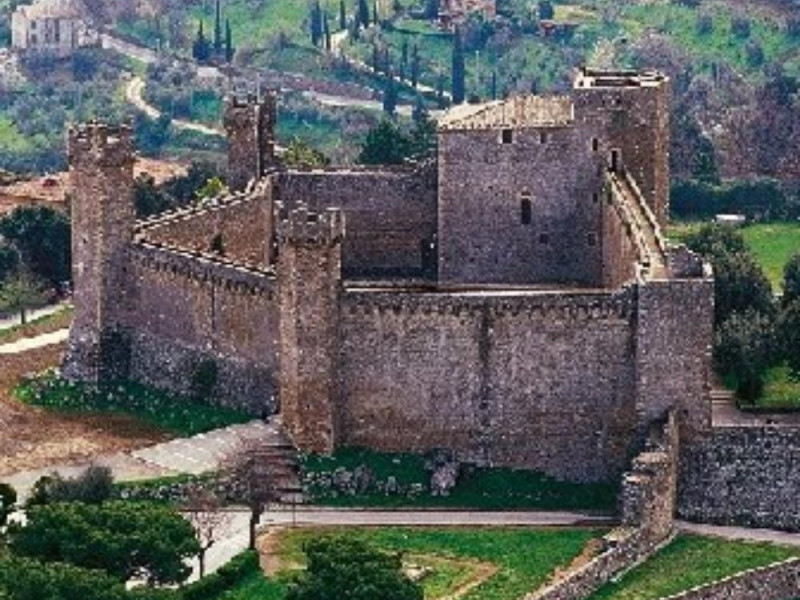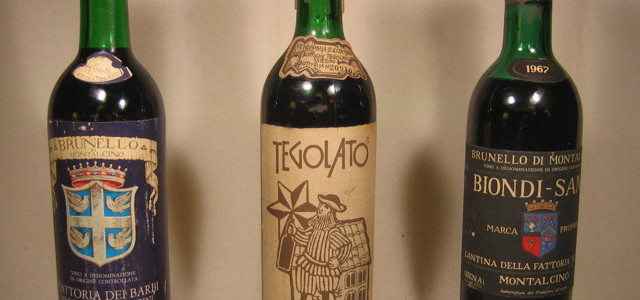Destinazioni - Comune
Montalcino
Where
Montalcino (Siena)
Montalcino is a hill town and comune in Tuscany, Italy. It is famous for its Brunello di Montalcino wine.
The town is located to the west of Pienza, close to the Crete Senesi in Val d'Orcia. It is 42 kilometres (26 mi) from Siena, 110 kilometres (68 mi) from Florence and 150 kilometres (93 mi) from Pisa. The Monte Amiata is located nearby.
History
The hill upon which Montalcino sits has probably been settled since Etruscan times. Its first mention in historical documents in 814 AD suggests there was a church here in the 9th century, most likely built by monks associated with the nearby Abbey of Sant'Antimo. The population grew suddenly in the middle of the tenth century, when people fleeing the nearby town of Roselle took up residence in the town.
The town takes its name from a variety of oak tree that once covered the terrain. The very high site of the town offers stunning views over the Asso, Ombrone and Arbia valleys of Tuscany, dotted with silvery olive orchards, vineyards, fields and villages. The lower slopes of the Montalcino hill itself are dominated by highly productive vines and olive orchards.
During medieval times the city was known for its tanneries and for the shoes and other leather goods that were made from the high-quality leathers that were produced there. As time went by, many medieval hill towns, including Montalcino, went into serious economic decline.
Like many of the medieval towns of Tuscany, Montalcino experienced long periods of peace and often enjoyed a measure of prosperity. This peace and prosperity was, however, interrupted by a number of extremely violent episodes.
During the late Middle Ages it was an independent commune with considerable importance owing to its location on the old Via Francigena, the main road between France and Rome, but increasingly Montalcino came under the sway of the larger and more aggressive city of Siena.
As a satellite of Siena since the Battle of Montaperti in 1260, Montalcino was deeply involved and affected by the conflicts in which Siena became embroiled, particularly in those with the city of Florence in the 14th and 15th centuries, and like many other cities in central and northern Italy, the town was also caught up in the internecine wars between the Ghibellines (supporters of the Holy Roman Empire) and the Guelphs (supporters of the Papacy). Factions from each side controlled the town at various times in the late medieval period.
Once Siena had been conquered by Florence under the rule of the Medici family in 1555, Montalcino held out for almost four years, but ultimately fell to the Florentines, under whose control it remained until the Grand Duchy of Tuscany was amalgamated into a united Italy in 1861.
In the case of Montalcino, gradual economic decline has recently been reversed by economic growth due to the increasing popularity of the town's famous wine Brunello di Montalcino, made from the sangiovese grosso grapes grown within the comune. The number of producers of the wine has grown from only 11 in the 1960s to more than 200 today, producing some 330,000 cases of the Brunello wine annually. Brunello was the first wine to be awarded Denominazione di Origine Controllata e Garantita (DOCG) status. In addition to Brunello di Montalcino, which must be aged five years prior to release, 6 years for the Riserva, Rosso di Montalcino (DOC), made from sangiovese grosso grapes and aged one year, and a variety of Super Tuscan wines are also produced within the comune, as well as the Moscadello sweet white wines for which it was most famous until the development of the Brunello series.
Main sights
The first medieval walls were built in the 13th century. The fortress was built at the highest point of the town in 1361, on a pentagonal plan designed by the Sienese architects Mino Foresi and Domenico di Feo. The fortress incorporates some of the pre-existing southern walls, the pre-existing structures including the keep of Santo Martini, the San Giovanni tower and an ancient basilica which now serves as the fortress chapel. Though the town itself was eventually conquered, the fortress itself was never taken, an admirable feat, considering the size of the Sienese and Florentine forces that besieged Montalcino at varying intervals.
Down the narrow, short street that extends from the main gate of the fortress is the Chiesa di Sant'Agostino with its simple Romanesque façade, also built in the 13th century.
The building adjacent to the church is a one-time convent, but it is now the home of the Musei Riuniti which is both a civic and diocesan museum. The museums hold various works, including a wooden crucifix by an unknown artist of the Sienese school, two beautiful 15th century wooden sculptures, including one of an incredibly moving Madonna by an anonymous artist which has become the symbol of Montalcino on the various posters and publicity, and several other sculptures in terracotta which appear to be of the Della Robbia school. The collection also includes a St Peter and St Paul by Ambrogio Lorenzetti and a Virgin and Child by Simone Martini. There are also more modern works from the beginning of the 20th century that offset and reflect the older works of art in the artful way they are presented by the curator.
The Duomo (cathedral), dedicated to San Salvatore, was originally built in the 14th Century, but it now has a neo-classical appearance thanks to extensive renovation work done in the early 19th century under the direction of Sienese architect Agostino Fantasici.
Originally the Piazza della Principessa Margherita is down the hill from the fortress and Duomo on the via Matteotti. The principal building on the piazza is the town hall, once the Palazzo dei Priori (built late 13th, early 14th century) which was for many years the Palazzo Comunale. The palace is adorned with the coats of arms of the Podesta, once rulers of the city. A very tall medieval tower is incorporated into the palazzo. Close by is a Renaissance structure with six round arches, called La Loggia, which was started at the very end of the 14th century and finished in the early 15th, but which has undergone much restoration work over the subsequent centuries.
Montalcino is divided, like most medieval Tuscan cities, into quarters called contrade, Borghetto, Travaglio, Pianello and Ruga, each with their own colours, songs and separate drum rhythms to distinguish them. Twice a year they meet together in a breath taking archery contest under the walls of the Fortezza, conducted in Medieval dress, with lords and ladies of each contrada who accompany the proceedings.
The 13th century church of San Francesco in the Castlevecchio contrada has undergone several renovations. Some of the interior frescoes were done by Vincenzo Tamagni in the early sixteenth century.
There are many other medieval buildings in Montalcino that make up its centro storico (historical center). As with many other similar cities, money from tourism is aiding the cause of restoration and preservation.
In 2010, the Festa Europea Della Musica had its first edition in Montalcino, to underscore and promote the beauty and culture of the town, and develop the artistic presence in the territorio as an "abbinamento" to the immense quality of its wines and way of life. Associated with the Fête de la Musique, created by Jack Lang in Paris in 1981 to celebrate music and musicians, the Festa was incorporated into the Italian Minister of Culture's agenda in 1994, and has since spread across Italy as well as the world, encouraging the cooperation and musical exchanges between the participating cities. Celebrated on the 21st of June, the entire town and its "frazioni" become one varicoloured musical tapestry that offsets beautifully the jewel of the territory itself.
Other sights
Churches with frescoes of the Sienese School
the Rocca, a ruined castle
Sant'Antimo, a nearby Benedictine abbey
Paleontological research into fossilised skeletons, notably a whale, at the wine estate Castello Banfi (former name: Poggio alle Mura) in 2007.
See also
Brunello di Montalcino
Val d'Orcia
References
External links


